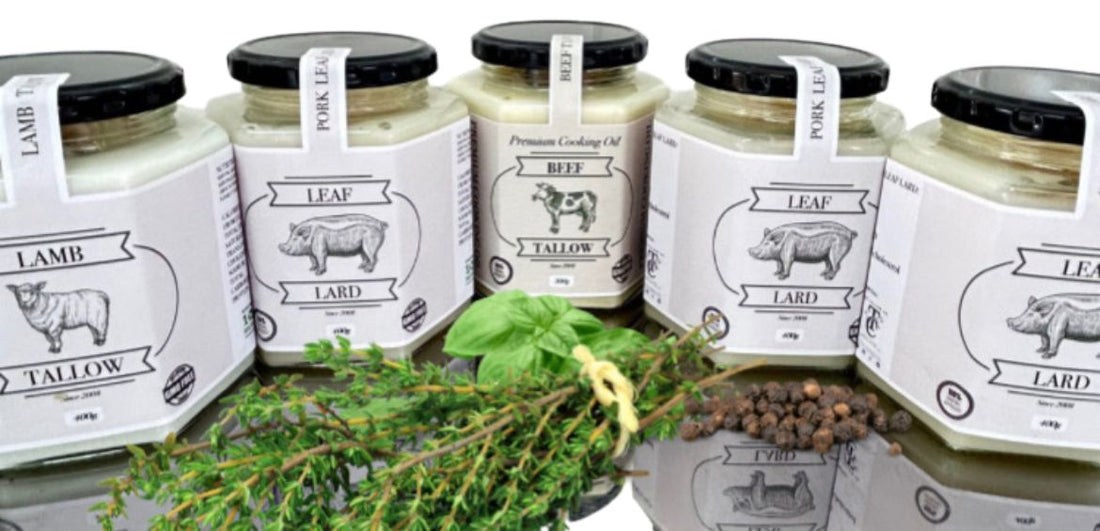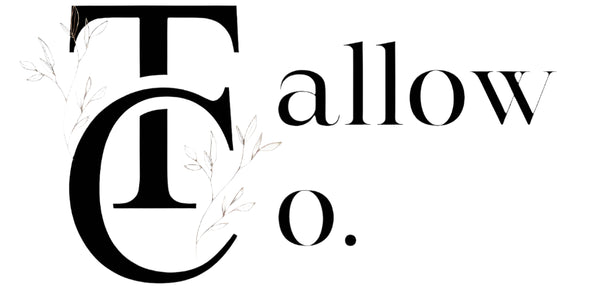
Tallow vs. Lard: What’s the Difference?
Share
If you’ve ever wandered into the world of traditional cooking fats or skincare DIYs, you’ve probably come across tallow and lard. These animal-based fats have been staples in kitchens and households for centuries, but what exactly sets them apart? While they might seem interchangeable at a glance, tallow and lard differ in their sources, properties, and uses. Let’s break it down.
What Is Tallow?
Tallow is a rendered fat derived from ruminant animals, most commonly beef cattle, though it can also come from sheep or deer. The fat is typically sourced from around the kidneys or other fatty areas of the animal, then melted down and purified through a process called rendering. The result? A solid, waxy fat that’s rich in nutrients like conjugated linoleic acid (CLA) and fat-soluble vitamins (A, D, E, and K), especially if it’s from grass-fed animals.
Tallow has a high smoke point—around 400°F (205°C)—which makes it a favorite for frying or roasting. Historically, it’s been used for everything from candle-making to soap production, and it’s even found a modern resurgence in skincare for its moisturizing properties.
What Is Lard?
Lard, on the other hand, is rendered fat from pigs. It’s usually sourced from the pig’s back, belly, or around the internal organs (leaf lard, the highest quality type, comes specifically from around the kidneys). Like tallow, it’s made by rendering—heating the fat until it melts, then straining out impurities. The end product is a creamy, soft fat that’s slightly less firm than tallow at room temperature.
Lard’s smoke point is a bit lower than tallow’s, hovering around 370°F (188°C), but it’s prized in baking for the flaky, tender texture it lends to pie crusts and biscuits. It’s also packed with monounsaturated fats (like those in olive oil) and vitamin D, particularly from pasture-raised pigs.
Key Differences
Here’s where tallow and lard part ways:
1. Animal Source
• Tallow: Beef, sheep, or other ruminants.
• Lard: Pigs only.
2. Texture and Consistency
• Tallow is harder and more brittle, thanks to its higher saturated fat content (around 50-55%).
• Lard is softer and creamier, with a slightly lower saturated fat percentage (about 40%).
3. Flavor
• Tallow has a subtle beefy undertone, which can enhance savory dishes like roasted potatoes or fried chicken.
• Lard is milder and more neutral, making it a go-to for pastries where you don’t want a strong flavor to shine through.
4. Smoke Point
• Tallow’s higher smoke point (400°F) makes it better for high-heat cooking.
• Lard (370°F) is still great for frying but shines in medium-heat applications like sautéing or baking.
5. Nutritional Profile
• Both are rich in healthy fats, but tallow tends to have more CLA (linked to anti-inflammatory benefits), while lard boasts more monounsaturated fats, which are heart-healthy in moderation.
Uses: Kitchen and Beyond
In the kitchen, tallow is your heavy-duty fat—think crispy fries or a rich sear on a steak. Lard, with its delicate texture, is the baker’s secret weapon for flaky pie crusts or fluffy biscuits. But their utility doesn’t stop there. Tallow’s stability and nutrient density make it a star in homemade balms and salves, while lard’s creaminess has earned it a spot in traditional soap recipes.
Which One Should You Choose?
It depends on what you’re after. If you’re frying at high heat or want a beefy boost, go for tallow. If you’re baking or need a neutral fat, lard’s your pick. And if you’re sourcing them yourself, look for grass-fed beef for tallow or pasture-raised pork for lard—the quality of the animal’s diet makes a big difference in flavor and nutrition.
Final Thoughts
Tallow and lard are both throwbacks to a time when every part of an animal was put to use, and they’re enjoying a well-deserved comeback. They’re natural, versatile, and packed with character—whether you’re crisping up hashbrowns or whipping up a moisturizer. So, next time you’re at the butcher or rendering your own, you’ll know exactly which fat fits the bill.
